When it comes to enhancing nuts’ nutritional profile and digestibility, a straightforward technique comes into play – soaking and drying.
This method, often employed in various dietary approaches like the paleo diet, helps to maximize nutrient absorption and ease digestion by mitigating the impact of phytonutrients. The following sections will guide you through this simple process of how to dehydrate nuts.
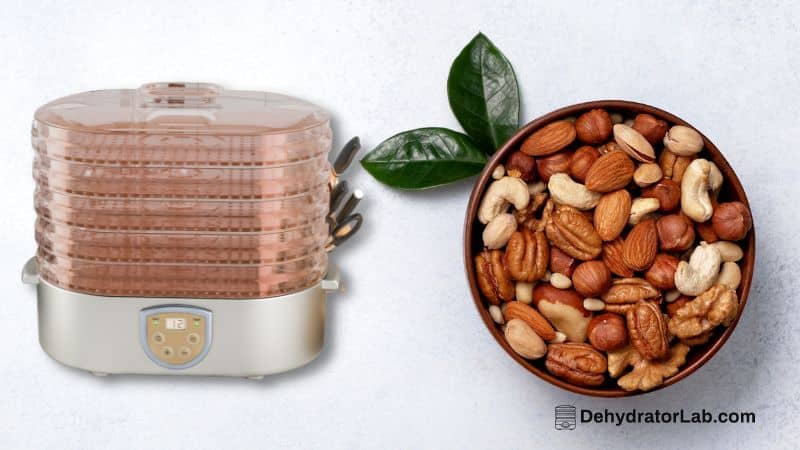
As an Amazon Associate, I earn from qualifying purchases. If you make a purchase after clicking on a link I may earn a small commission at no extra cost to you if items are purchased.
In this article:
Key Takeaways on How to Dehydrate Nuts
- 💪 Digesting nuts can be challenging for the body and may hinder nutrient absorption, making the soaking and drying process beneficial for better overall health.
- 🌱 The concept of soaking nuts overnight is a simple and effective way to enhance the nutrients our bodies can absorb from them.
- 🥝 Soaking nuts in a glass container with a lid can prevent insects and critters from contaminating the nuts during the soaking process.
- 💧 It’s important to add more water than necessary when soaking nuts to account for their expansion.
- 🥜 Properly dried nuts can be stored in airtight containers in the pantry, making them convenient for snacking or using in recipes like blender waffles.
Soaking and Drying Nuts
Nuts, though loaded with essential nutrients, can be challenging for the body to digest due to their phytonutrient content. These phytonutrients can bind with other elements in our system, essentially robbing us of some nutrients instead of nourishing us.
By soaking and drying nuts, we can counteract this effect, making these delightful snacks more health-friendly.
This soaking practice mirrors the common culinary tradition of pre-soaking grains or beans before cooking, effectively enhancing their digestibility and nutrient availability.
Preparing Your Nuts: The Soaking Process
Start by choosing a sufficiently large glass container for your nuts. A half-gallon jar or a large glass bowl would be perfect for this purpose. You’ll likely fill about half of your chosen container with nuts.
It’s essential to ensure you have a lid for your container, especially if your kitchen is prone to flies or fruit flies, as you definitely don’t want any unwanted guests invading your nut-soaking process.
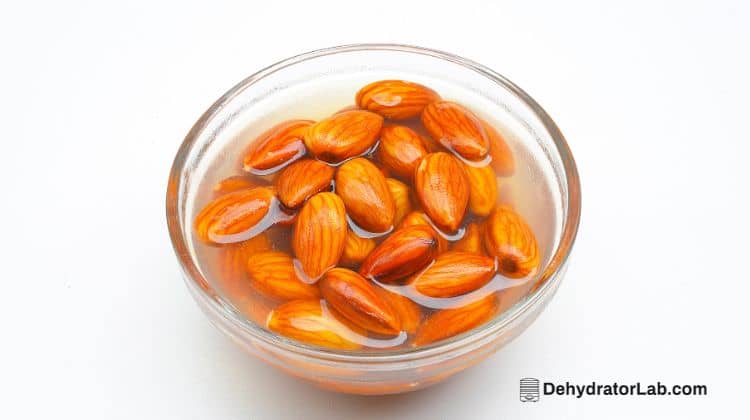
Pour enough water into the container to not just cover the nuts but significantly exceed their volume as the nuts are going to expand slightly. The soaking process usually runs overnight, allowing ample time for the nuts to absorb water.
Draining and Drying (In the Food Dehydrator)
In the morning, drain the soaked nuts using a large colander and then evenly spread them out on dehydrator trays. Sprinkle some salt over the nuts for added flavor before placing them in the dehydrator (I use the 6-tray Cosori model).
The temperature setting for the dehydrator isn’t crucial as long as it is turned on. A mid-range temperature setting is generally sufficient.
The nuts will need to be dried for at least 12 hours, but sometimes it may take up to 24 hours or more depending on various factors such as the time of the year, the humidity level in your house, and the temperature you set on the dehydrator.
The key indicator to watch for is that the nuts should turn crispy, indicating all the moisture has been removed.
Storage and Usage
Once the nuts are completely dried and crispy, store them in airtight containers and keep them in your pantry. This process is recommended for all types of nuts and is particularly useful if you are using them for baking or just consuming them as a snack.
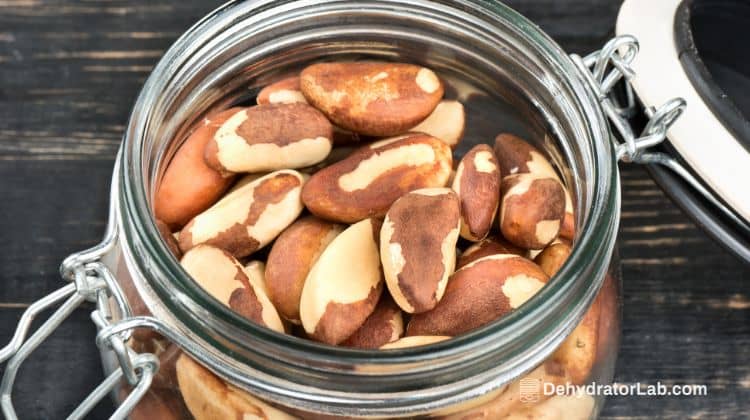
Thus, the process of soaking and drying your nuts is simple and very beneficial to enhance the nutritional value and digestibility of your favorite nuts. Give it a try, and enjoy your healthier, crunchier, and tastier nuts!
Frequently Asked Questions
Do you have to dry nuts after soaking?
Yes, it’s crucial to dry nuts after soaking to remove all the moisture. This ensures they stay crunchy and prevents any possible mold or bacterial growth that could occur in a damp environment.
How do you soak and dry raw almonds?
To soak and dry raw almonds, follow these steps:
- Place your raw almonds in a large glass container.
- Fill the container with enough water to fully submerge the almonds and allow for their expansion.
- Cover and let them soak overnight.
- In the morning, drain the almonds and spread them out on dehydrator trays.
- Sprinkle some salt over the almonds and place them in the dehydrator.
- Dry the almonds at a medium temperature setting for at least 12 hours, or until completely dry and crispy.
How do you dry nuts without a dehydrator?
If you don’t have a dehydrator, you can dry nuts in an oven (or browse our reviews for one). Spread the soaked nuts evenly on a baking tray and put them in an oven set at a low temperature (around 150 degrees Fahrenheit or 65 degrees Celsius).
Leave the oven door slightly open to allow moisture to escape. Check the nuts regularly and stir them around until they are thoroughly dry and crispy.
How long should you soak nuts?
Nuts should generally be soaked overnight, which is typically around 8 to 12 hours. However, the soaking time may vary depending on the type of nut. For instance, softer nuts like cashews might require a shorter soaking time to avoid becoming too soft.
Is it necessary to refrigerate soaked and dried nuts?
After the nuts are thoroughly dried, it is not necessary to refrigerate them. They can be stored in an airtight container in your pantry. However, if you live in a very humid climate or want to extend the shelf life of the nuts, refrigeration can be beneficial.

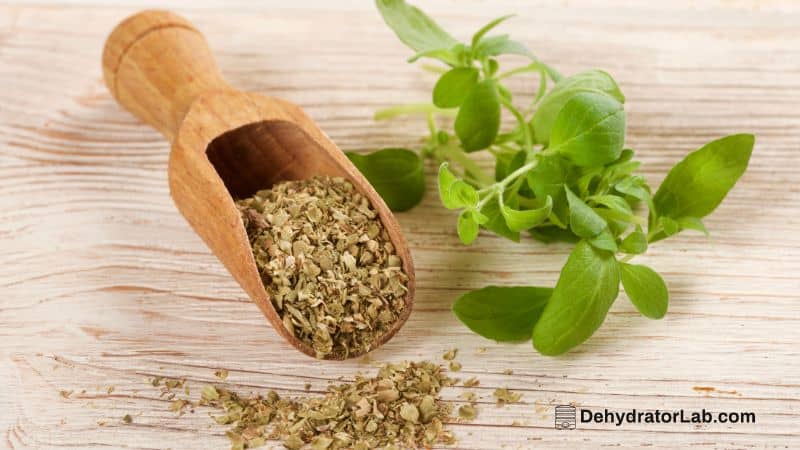
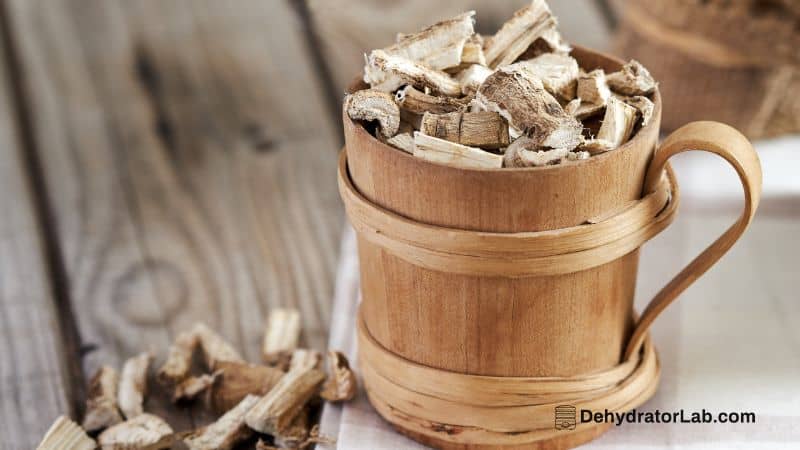
![How to Dehydrate Basil [3 Easy Methods] in 2023](https://dehydratorlab.com/wp-content/uploads/2023/07/How-to-Dehydrate-Basil.jpg)